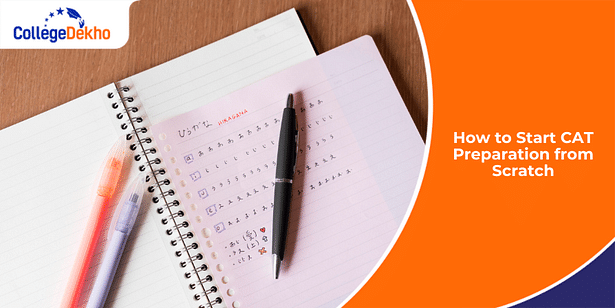
How to start CAT preparation 2025 from scratch might seem daunting at first, but with the correct strategy, you can lay a solid foundation even if you are beginning from scratch. The CAT 2025 exam is broken down into three broad sections: VARC (Verbal Ability and Reading Comprehension), DILR (Data Interpretation and Logical Reasoning), and QA (Quantitative Aptitude). Each section tests different skills, such as comprehending complex texts, solving logical questions, and processing numbers fast and accurately.
First, get accustomed to the CAT 2025 exam pattern and understand your strengths and weaknesses. Read constantly to improve your grasp, solve reasoning puzzles, and brush up on your basics of mathematics. Proper, step-by-step planning and consistent practice will enable you to excel. Since over 3 lakh students take the test each year, competition is stiff. So, if you are on the lookout for methods to know how to start CAT preparation 2025 from scratch, this is the perfect time to start.

Also Read:
CAT 2025 Important Dates
Before we dive into how to start CAT preparation 2025 from scratch, let us first have a look at the CAT 2025 important dates:
Events | CAT Important Dates 2025 |
|---|---|
CAT 2025 notification release | July 30, 2025 |
CAT 2025 registration starts | August 2, 2025 |
CAT 2025 Registration ends | September 13, 2025 |
CAT 2025 admit card | October 25, 2025 |
CAT 2025 exam date | November 26, 2025 |
Release of CAT 2025 Response Sheet & Question Paper | 2nd week of December 2025 |
Last day to challenge the answer key | Second week of December 2025 |
CAT 2025 Result | Second week of January 2026 |
Understanding the CAT Exam Pattern 2025
The CAT exam for the year 2025 would follow a similar exam pattern to previous years. Here's an overview of what you can expect from the CAT 2025:
Section | Total Questions | Total MCQs (With Negative Marking) | Total Non-MCQs (Without Negative Marking) | Time Limit |
|---|---|---|---|---|
Verbal Ability & Reading Comprehension | 24 | 19 | 5 | 40 Minutes |
Data Interpretation & Logical Reasoning | 20 | 15 | 5 | 40 Minutes |
Quantitative Ability | 22 | 14 | 8 | 40 Minutes |
Total | 66 | 48 | 18 | 120 Minutes |
How to Start Preparing for CAT VARC from Scratch
Preparing for the Verbal Ability and Reading Comprehension (VARC) section of the Common Admission Test (CAT) from scratch can be a challenging task, but rewarding too. Your reading, comprehension, and language skills are assessed in this section. Here's a step-by-step guide on how to start your CAT VARC preparation from scratch:
Understand the CAT VARC Syllabus
The CAT VARC section includes a wide range of topics such as English Usage or Grammar Vocabulary Based (Synonyms/ Antonyms), Fill in the blanks, Sentence Correction, Cloze Passage, Jumbled Paragraph, Meaning-Usage Match and so on. Without having a basic idea of the same, starting with your preparation would not be that effective.Assess Your Current Skills
Once you have gathered some sort of familiarity with the CAT VARC syllabus, earmark some time to simply identify your current strengths and weaknesses. For instance, if you think you are good at RCs, practice more of them, but do not ignore the rest of the topics.Reading Habit Formation
The best trick to ace the CAT VARC section is to form a reading habit which can be done by reading newspapers and editorials on a daily basis. Reading on a daily basis will increase your power of visualization. Also, remember, it only takes 21 days to build a habit. So, get on with it right NOW!
Vocabulary Building
Yes, reading newspapers will help build your vocabulary, but it will take time. So, the quickest way to go about it is by picking up vocabulary books like 'The Vocabulary Builder Workbook' by Chris Lele, 'Word Power Made Easy' by Norman Lewis, and likewise. Use flashcards or vocabulary apps to learn new words daily and revise them regularly. Also, try to grasp the usage of words in different contexts.
Practice Reading Comprehension Regularly
Solving RC passages regularly will help you focus on understanding the main idea of the passage, identifying supporting details, and comprehending the author's tone and purpose. Candidates must practice RC passages from a wide range of topics to improve their comprehension skills. It is also advisable that the candidates spend a considerable amount of time reading excerpts from the editorial section of newspapers like The Tribune, The Hindu, Indian Express, etc.
Improve Your Grammar
To improve your grammar, brush up on basic grammar rules and concepts. You may also get a new Grammar Manual to learn new grammar rules. The topics that must be practised more include parts of speech, tenses, para jumbles, para summary, odd sentence out, and inferences, and punctuation.
Practice Various Grammar Questions Regularly
Don't forget to solve the questions in the 'Exercises' segment of the Grammar Manuals to revise the important concepts and familiarise yourself with different question types commonly asked in the VARC section. Practice a variety of question types regularly to improve your accuracy and speed.
Also Read: How to Prepare for CAT VARC
How to Start Preparing for CAT Quant from Scratch
Preparing for the Quantitative Aptitude section of the CAT exam from scratch can be challenging, but with a structured plan and dedication, you can achieve anything. Here are the steps on how to start preparing for CAT Quant from scratch:
Start with the Basics
Quant can undoubtedly be called the 'toughest section in CAT' for many aspirants. However, those with a strong foundation do have an edge. Those who are beginners must ensure to have their basics sorted before moving on to the CAT Quant syllabus.
Identifying the Most Important CAT Quant Topics
Previous year CAT papers tell us that Arithmetic, Algebra, Modern Maths, Number System, Geometry and Mensuration form the base of the CAT 2025 QA syllabus. Make sure your concepts are clear when it comes to these topics.
Create a Study Schedule
Almost no one can crack Quant without having a well-thought-out schedule. Chalk it out based on how much time you have on hand and divide it into the topics that you need to cover.
Practice Regularly
Practice, practice and practice! Every CAT topper would tell you the same thing — the only way to ace this section is by thorough and regular practice. This can be done using the CAT previous year question papers , CAT sample papers , and CAT 2025 mock tests .
Learn Crucial Formulae and Shortcuts
CAT Quant prep would require you to learn a long list of formulae. However, learning just around 50+ more important formulas would do wonders. Since there will be sectional time limits for each section in the CAT exam, learn shortcut methods to save time while answering questions.
Work on Time Management
This section is solving as many questions as possible within the given amount of time. Hence, speed becomes a critical factor for Quant preparation. So, make sure to focus on it while taking timed mock tests.
Also Read: How to Prepare for CAT Quantitative Ability (QA) 2025
How to Start Preparing for CAT DILR from Scratch
Preparing for the Data Interpretation and Logical Reasoning (DILR) section of the CAT exam from scratch can be a challenging but achievable task if you plan everything perfectly. Here are the steps to help you get started:
Learn Basic DILR Concepts
Begin your preparation by understanding the basic concepts and principles of data interpretation and logical reasoning. Give more importance to topics such as ratios, averages, percentages, data analysis techniques, logical deductions, and arrangement puzzles.Learn Mental Calculation
Since quick calculations are crucial for solving DILR questions within the time allotted of 40 minutes, it is important for candidates to improve their mental calculation skills. Practicing techniques like approximation, estimation, and shortcut methods help to speed up calculations.
Solve Practice Questions Daily
Make use of books, online resources, and practice papers to gain insight into the variety of questions asked in the CAT exam, and start solving practice questions from DILR topics regularly. Start solving easier questions first and gradually move on to solving more complex questions as you gain confidence.
Practice Different Types of Data Sets, Logical Reasoning Puzzles and Caselets
Make it a habit to practise various types of data sets such as tables, bar graphs, line graphs, pie charts, and Venn diagrams and logical reasoning puzzles such as seating arrangements, blood relations, direction sense, and coding-decoding problems to understand how to understand the data presented. Grid puzzles, Einstein puzzles, etc., are some of the puzzles with set templates. They will help you find that constraint to answer two questions and look for a good starting point. This will enhance your problem-solving skills and logical reasoning abilities. Practice more and more questions to improve your speed and accuracy. Also, formulate an effective strategy for analysing and interpreting the information presented in caselets efficiently.
Utilisation of Time
For CAT DILR, you need to be smart and see how you can make the most out of the given time. But do not forget to pick the right questions. If you do both of these, you have almost won the game.
Question Selection
Identify which sets to solve and which not to solve. The sets in CAT DILR are easy, moderate or difficult and therefore, selecting the right sets is crucial.
Find Out Template Questions
This section requires you to get used to the different question templates that IIMs usually stick with. The usual Bar graphs and pie charts will get you acquainted with the section and give you a perspective on the ways you need to look at data sets.
Take As Many Mock Tests As Possible
The tricks to solve DILR questions come with experience and that can be achieved only through mock tests. You get to know what NOT to do in the exam.
Also Read: How to Prepare for CAT DILR 2025
Finally, it may seem like a difficult task to begin preparing for your CAT exam from scratch, but with the right attitude, resources, and dedication, you can become an excellent candidate. Stay on track, practice regularly, seek guidance if necessary, and keep the end goal in mind. The CAT exam is not only a test of knowledge, it's an assessment of your determination, strength, and ability to solve problems. Let's get going today and believe in ourselves, and who knows you may be on your way to an amazing management career soon. Good Luck!
Related Links:
For admission-related guidance, fill out our Common Admission Form or call the student helpline number 1800-572-9877 (toll-free). Our admission experts will be glad to help you out. If you have any other doubts about the CAT 2025 examination, you can ask questions in the Q&A zone . Stay tuned with us for more updates!
Are you feeling lost and unsure about what career path to take after completing 12th standard?
Say goodbye to confusion and hello to a bright future!

FAQs
If you are beginning from scratch for CAT preparation, coaching can be used but not necessary. Coaching provides systematic teaching, expert guidance, and test practice that is similar to the original test. Yet, most of the toppers prepare on their own by way of online materials, books, and previous question papers. If you are serious, coaching is not necessary—but it can speed up learning and provide consistency. Choose your learning style and time commitment before making the decision.
You should basically adopt a systematic approach for solving DI-LR problems. Practice different types of puzzles and data interpretation sets to improve your skills.
You can enhance your Verbal Ability and Reading Comprehension skills by Reading newspapers, books, and articles regularly to improve your reading speed and comprehension. Practice solving RC passages and take vocabulary-building exercises.
To improve your quantitative aptitude for CAT if you are starting from scratch, you should brush up on basic math concepts, practice regularly, and solve a variety of problems from different sources. Focus on time management during the exam.
You will need CAT study guides, textbooks, online resources, and mock test series. Consider enrolling in a coaching program if you need additional guidance.
To create an effective study plan for CAT preparation if you are preparing from scratch, it should include a structured timetable, allocation of time for each section, and regular practice tests. Prioritize weak areas and allocate more time to them.
First of all, start by understanding the CAT exam pattern, syllabus, and eligibility criteria. Then set clear goals, create a study plan, and gather necessary study materials.
Was this article helpful?


















Similar Articles
CAT 2025 DILR Topic-wise Weightage
Can I Do MBA After Diploma?
Self-Study for CAT 2025: Step-by-Step Guide
CAT vs CMAT, NMAT, XAT, SNAP & Other MBA Entrance Exams
How Much CAT 2025 Percentile is Required in IIM for General?
NMAT XIMB Cutoff 2025: Expected & Previous Year Cutoff